Kaiten-sushi (conveyor belt sushi) restaurants have become an iconic part of Japanese food culture, offering affordable and accessible sushi experiences for everyone. Unlike high-end sushi establishments that cater primarily to corporate employees and formal gatherings, kaiten-sushi chains welcome families, tourists, and casual diners of all ages.
This guide presents the top 20 favorite sushi toppings based on a survey of 500 men and women conducted by Mynavi News (a major Japanese online news platform) and published in April 2023. We also cover the most popular side dishes and desserts from Japan’s “Big Three” kaiten-sushi chains: Sushiro, Kura Sushi, and Hama Sushi. When visiting Japan, you can use this guide while ordering at kaiten-sushi restaurants—it’s a reliable way to ensure you try the most popular and beloved items.
While sushi topping preferences at conveyor belt restaurants closely mirror those at high-end establishments, most side dishes (except for seafood soups and miso soup) and nearly all desserts featured at kaiten-sushi chains are not available at premium sushi restaurants. This difference reflects their distinct target demographics—kaiten-sushi chains work hard to attract female customers and families with children, while high-end sushi restaurants primarily cater to corporate businesspeople.
Top 20 Popular Sushi Toppings (By Percentage of Customer Preference)
For each sushi topping, we’ve included information about its peak season, as seasonal fish and seafood not only taste better but also offer maximum nutritional value when consumed in season.
1.Salmon (17.4%)
Salmon sushi features rich, fatty salmon atop vinegared rice. It’s packed with protein and omega-3 fatty acids, along with vitamins D and B complex that benefit brain and heart health. The best season for salmon is early summer through autumn, when it has a perfect firm yet tender texture. Salmon is relatively affordable at kaiten-sushi chains, making it an accessible luxury that explains its overwhelming popularity.
Salmon(Saamon)
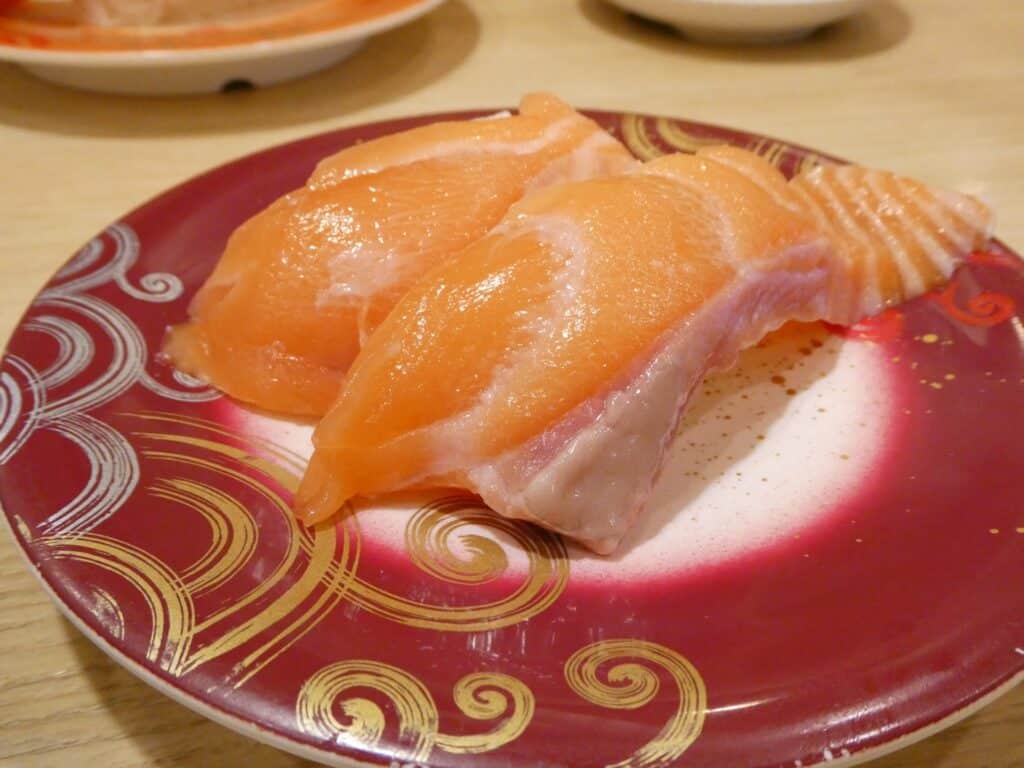
2. Medium-Fatty Tuna (Chū-toro) (8.4%)
Medium-fatty tuna comes from the part between the lean red meat and the fatty belly of the tuna. It offers a perfect balance of rich flavor and melt-in-your-mouth texture without being too heavy. Bluefin tuna is at its most delicious in winter (December to February) when the fat content is optimal. Medium-fatty tuna contains high-quality protein, vitamin D, niacin, and iron. While somewhat pricier than regular options at conveyor belt restaurants, it’s still more affordable than the premium o-toro (fatty tuna).
Medium-Fatty Tuna (Chū-toro)
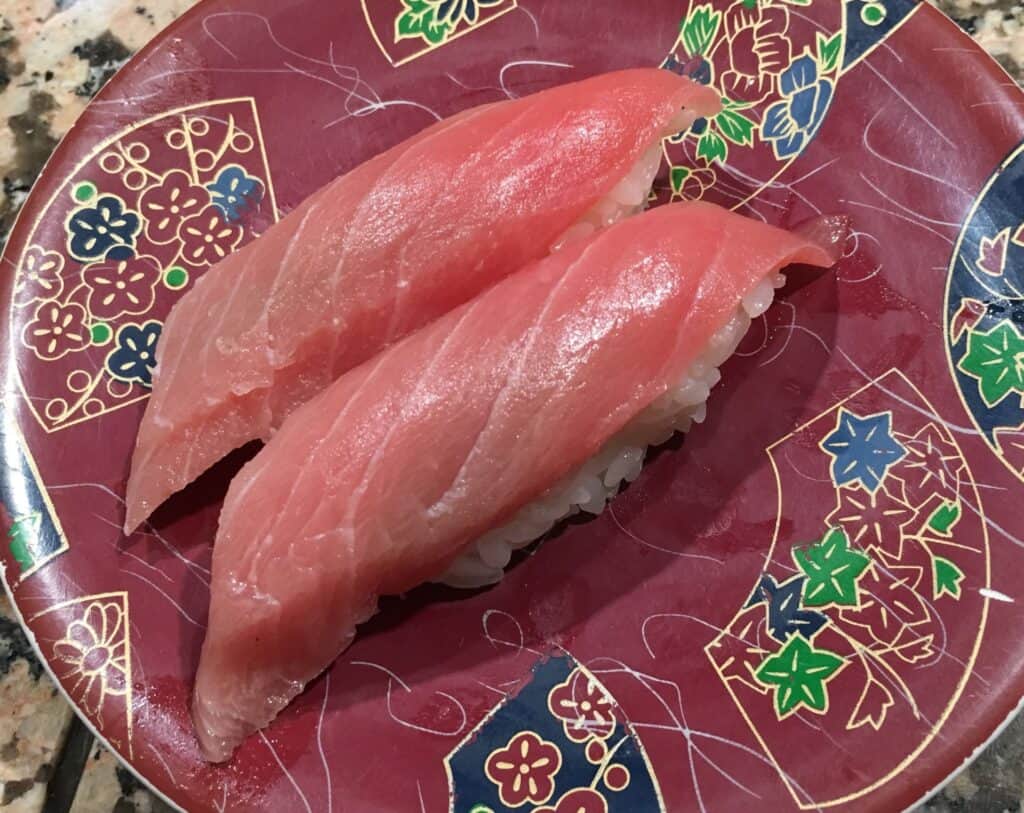
3. Seared Salmon (Aburi Salmon) (6.8%)
Seared salmon is quickly torched on the surface, creating a fragrant, smoky flavor while maintaining the raw, tender interior. This heating process enhances the fatty sweetness and creates a contrasting texture. Like regular salmon, its peak season is early summer through autumn. The searing process may increase the absorption rate of its abundant omega-3 fatty acids. It’s typically priced slightly higher than regular salmon but remains reasonably affordable.
Seared Salmon (Aburi Saamon)

4. Minced Tuna with Green Onion (Negitoro) (5.2%)
Negitoro combines scraped tuna with finely chopped green onions, creating a harmonious blend of tuna’s umami and the fresh aroma of green onions. Following tuna’s seasonality, winter offers the best quality, though it’s popular year-round. Nutritionally, it provides protein and iron from tuna along with vitamin C and potassium from green onions. Negitoro is typically reasonably priced at kaiten-sushi restaurants, offering excellent value.
Minced Tuna with Green Onion (Negitoro)
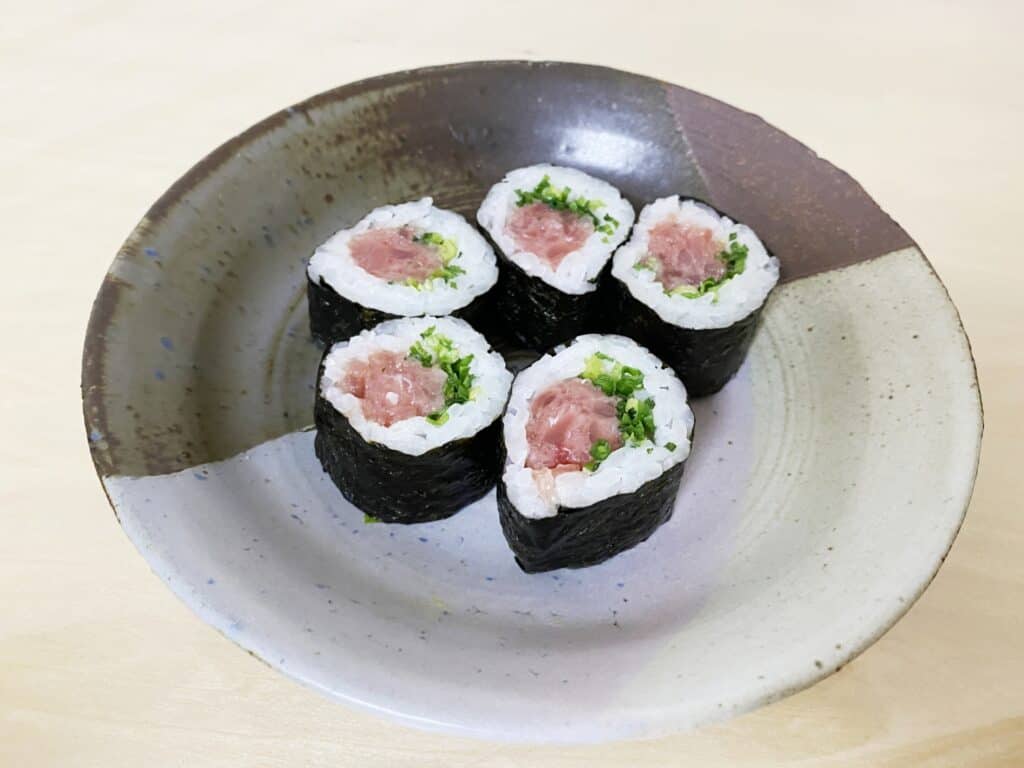
5. Flounder Fin (Engawa) (4.0%)
Engawa is the muscular edge of flatfish like flounder or sole, prized for its distinctive crunchy texture. Despite its delicate flavor, it delivers a rich umami as you chew. Flounder is in season during spring and summer, while sole peaks in winter through spring. Engawa is low in fat but high in protein and collagen, potentially offering skin benefits. While reasonably priced at conveyor belt restaurants, premium engawa at high-end establishments can be quite expensive.
Flounder Fin (Engawa)
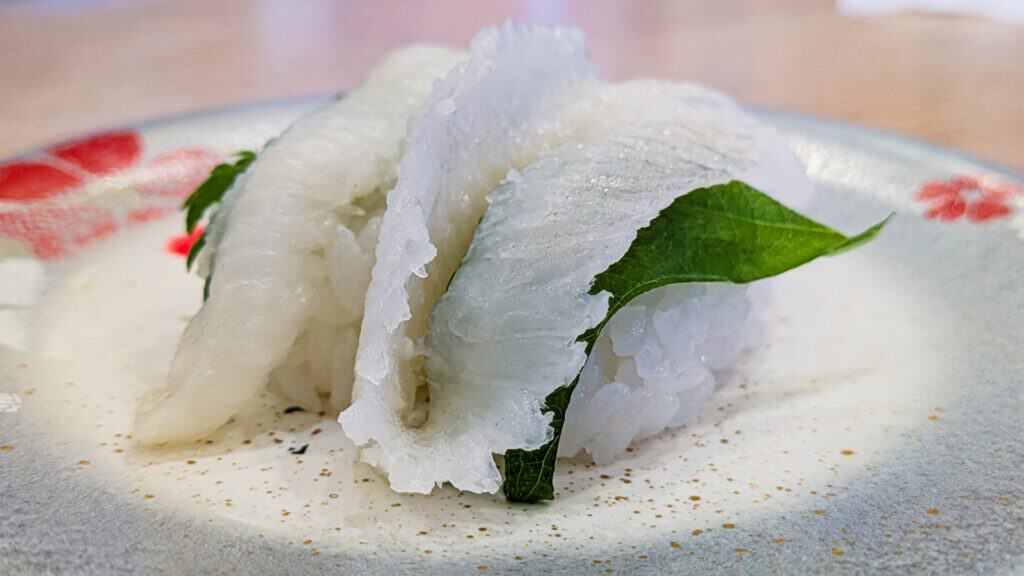
6. Fatty Tuna (Ō-toro) (3.4%)
Fatty tuna, from the richest part of the tuna’s belly, is the pinnacle of luxury sushi toppings. Known for its melt-in-your-mouth texture and intense, buttery flavor, bluefin o-toro is at its peak in winter. It contains healthy unsaturated fatty acids and quality proteins. Price considerations are especially important with o-toro—it can cost thousands of yen per piece at high-end sushi restaurants, and even at conveyor belt chains, it’s typically among the premium-priced plates. When genuine bluefin fatty tuna is used, prices climb even higher, so budget-conscious diners should check prices before ordering.
Fatty Tuna (Ō-toro)
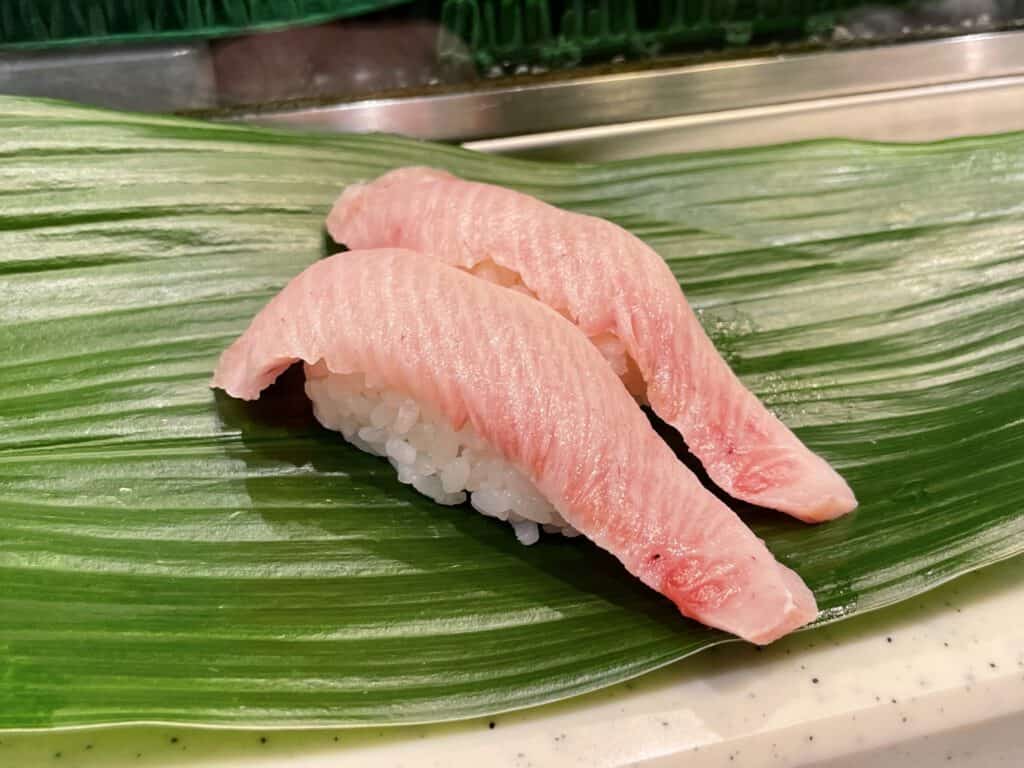
7.Yellowtail (Hamachi/Buri) (3.2%)
Hamachi is young yellowtail, offering clean but rich flavor with a refreshing finish. As it grows, it’s called buri and then mejiro. Its balanced fat content makes it approachable for sushi beginners. Winter is the peak season, with “cold yellowtail” (kanburi) being particularly prized. It’s rich in vitamins D and E, along with healthy DHA and EPA fatty acids. Yellowtail is relatively affordable at most kaiten-sushi restaurants.
Yellowtail (Hamachi/Buri)
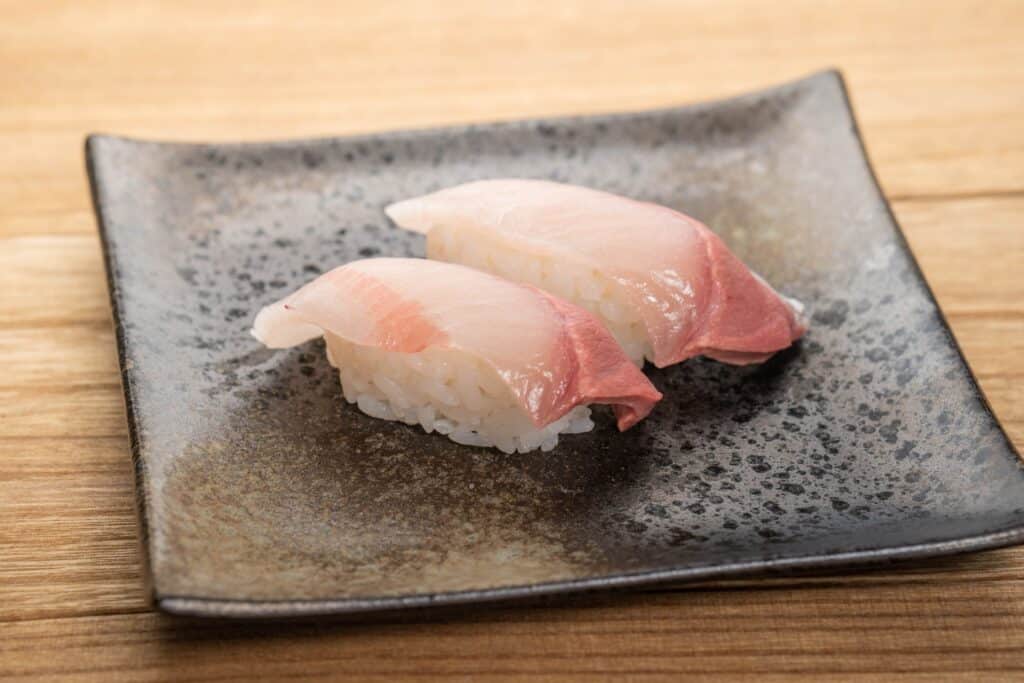
7. Seared Tuna (Tuna Tataki) (3.2%) [tied]
Seared tuna features a lightly torched exterior while maintaining a raw interior, creating a contrast between the aromatic surface and the fresh taste inside. Following tuna’s seasonality, winter is the best time to enjoy this topping. Nutritionally, it provides high-quality protein and iron, with the searing potentially enhancing fat absorption. Seared tuna is typically offered at standard prices in conveyor belt restaurants.
Seared Tuna (Tuna Tataki)
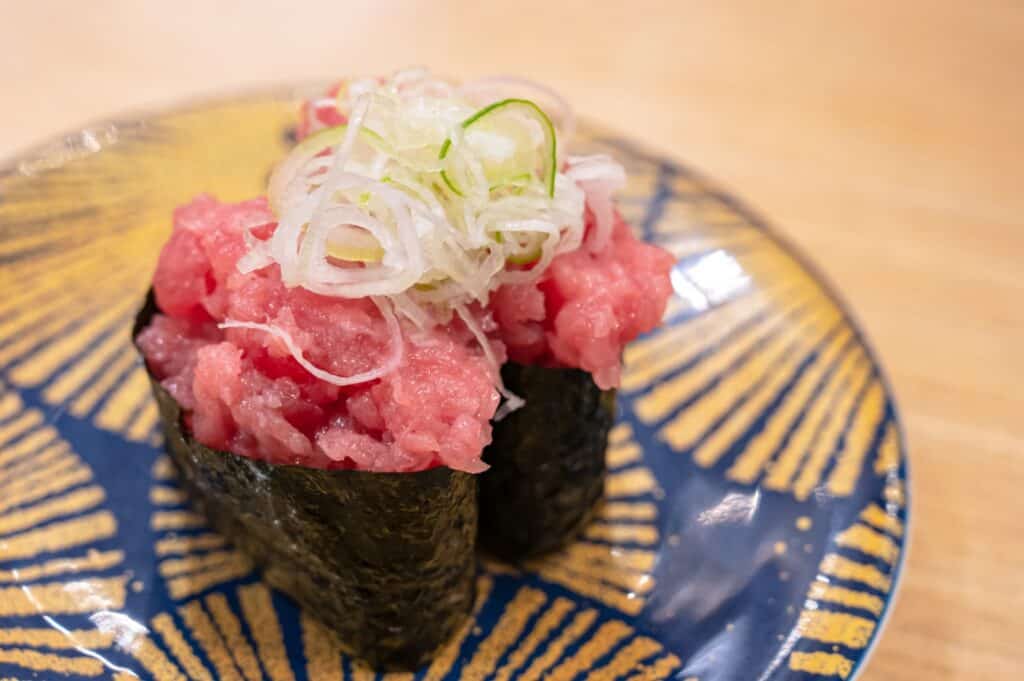
9. Salmon Roe (Ikura) (2.8%)
Ikura consists of salmon eggs, each bursting with rich flavor and a distinctive pop in your mouth. Typically marinated in soy sauce, these glistening orange pearls pair perfectly with rice. The peak season coincides with salmon spawning in autumn (September-November). Nutritionally, ikura offers quality protein, DHA, EPA, and vitamin E. It’s among the more expensive toppings at kaiten-sushi, and at high-end establishments, premium ikura can command very high prices. The quality can vary significantly, so price-conscious diners should check before ordering.
Salmon Roe (Ikura)

10.Rolled Omelet (Tamagoyaki) (2.4%)
Tamagoyaki is a slightly sweet rolled omelet, traditionally considered a benchmark of a sushi chef’s skill. Its gentle sweetness and soft texture make it popular with everyone from children to adults. Available year-round, it offers quality protein and vitamins B and D. Rolled omelet is among the most affordable options at conveyor belt restaurants, providing excellent value.
Rolled Omelet (Tamagoyaki)
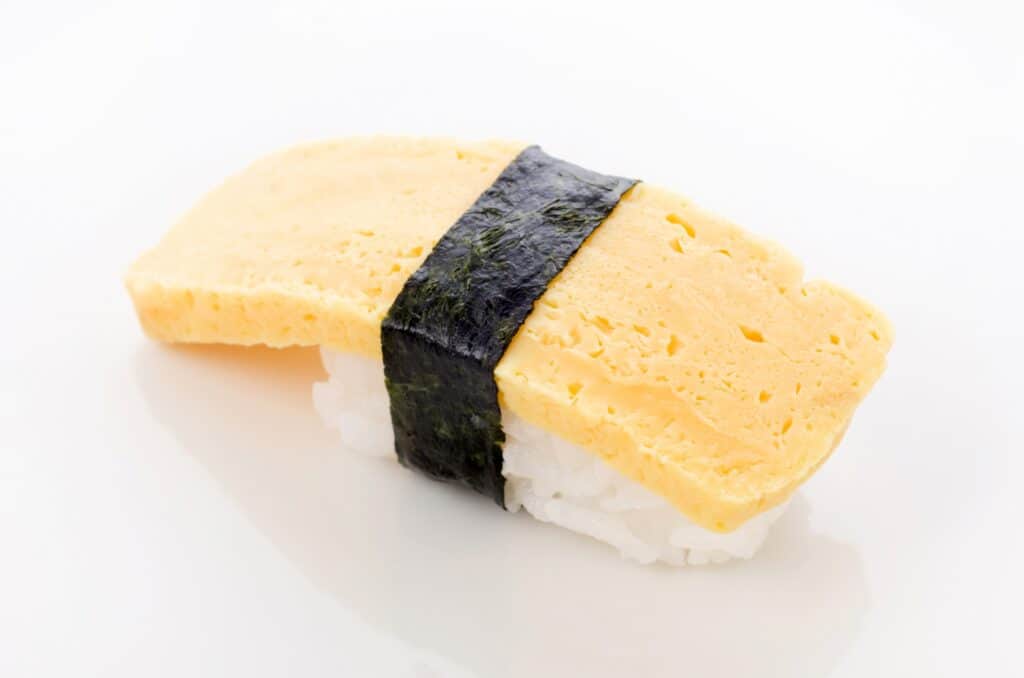
11.Steamed Shrimp (Mushi Ebi) (2.2%)
Steamed shrimp offers a sweet flavor and tender texture after gentle steaming, which enhances its natural sweetness. The most common kuruma ebi (Japanese tiger prawn) is at its best in winter through spring. It contains protein, calcium, taurine, and the antioxidant astaxanthin. Steamed shrimp is usually reasonably priced at kaiten-sushi restaurants.
Steamed Shrimp (Mushi Ebi)
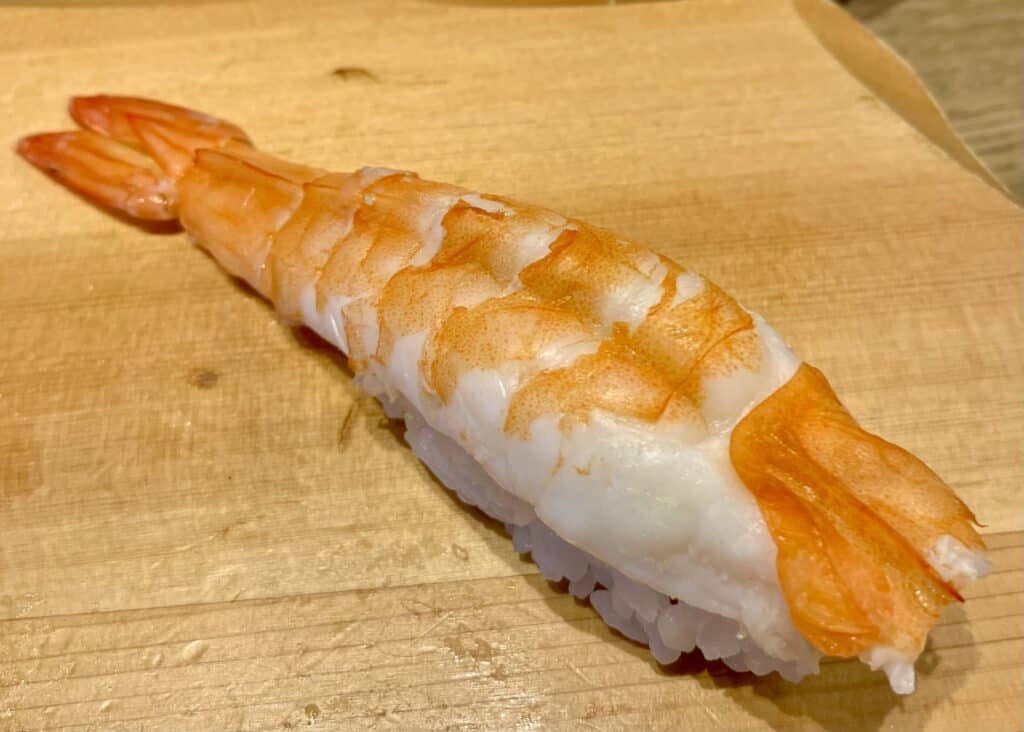
11. Squid (Ika) (2.2%) [tied]
Squid sushi showcases the delicate sweetness and distinctive crunchy texture of fresh squid, often scored on the surface for easier eating. Surume-ika (Japanese common squid) is in season during summer through autumn, while yari-ika (spear squid) peaks from winter through spring. It’s low in fat but high in protein, with substantial taurine and DHA content. Squid is typically among the more affordable toppings at conveyor belt restaurants.
Squid (Ika)

13.Greater Amberjack (Kanpachi) (2.2%)
Kanpachi is similar to yellowtail but with firmer flesh and a more refined taste. It offers a pleasant chewiness and elegant richness that earns it high regard among sushi connoisseurs. Its peak season is summer through autumn. Nutritionally, it provides quality protein, vitamin D, niacin, and omega-3 fatty acids. At kaiten-sushi restaurants, kanpachi typically falls into the mid-range price category.
Greater Amberjack (Kanpachi)
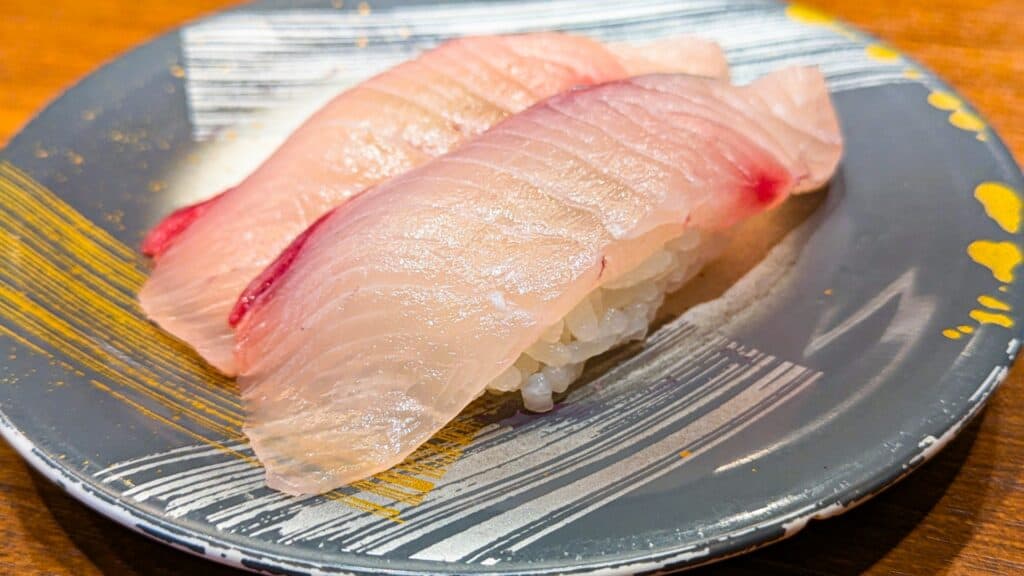
14.Tuna Roll (Tekka Maki) (2.0%)
Tekka maki is a simple roll containing lean tuna, offering concentrated tuna flavor in an accessible, easy-to-eat format popular with sushi beginners. Following tuna seasonality, winter offers the best flavor. It provides quality protein, iron, and vitamin E. Tuna rolls are among the most affordable options at conveyor belt restaurants, offering excellent value.
Tuna Roll (Tekka Maki)
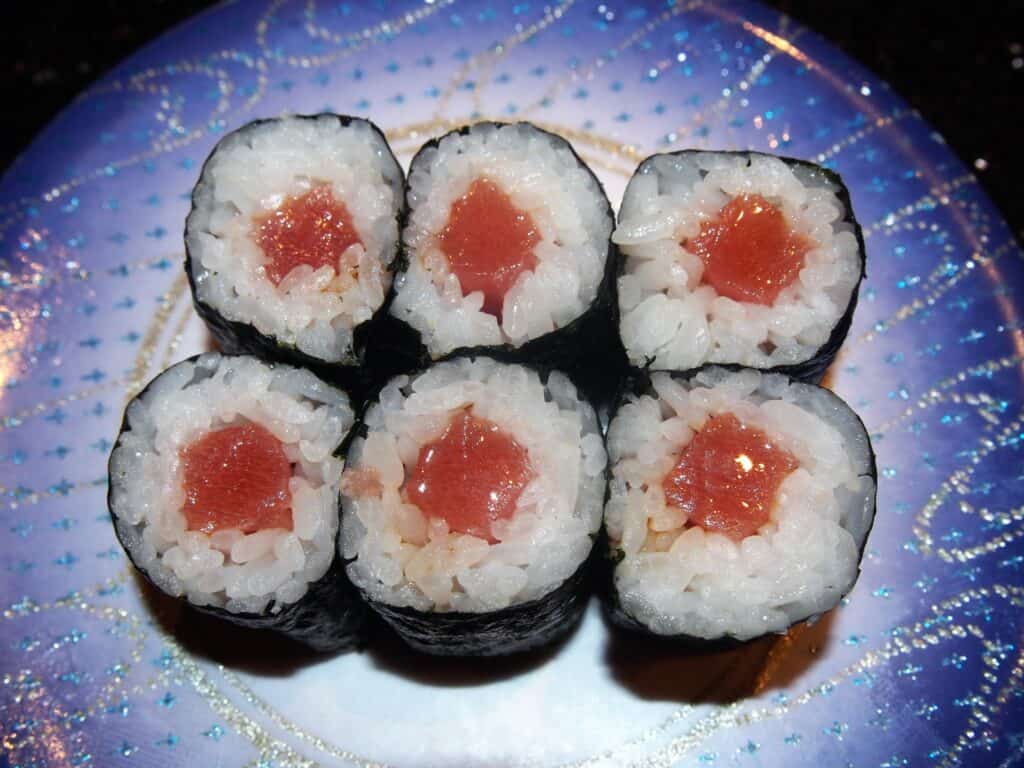
14.Botan Shrimp (Botan Ebi) (2.0%) [tied]
Botan shrimp is a large variety of sweet shrimp, named for its round, button-like shape. It offers intense sweetness and a firm texture, with a rich, creamy paste in the head. Its peak season is winter through spring. Nutritionally, it provides protein, astaxanthin, and calcium. As a premium shrimp variety, it’s typically priced higher than standard options at kaiten-sushi restaurants.
Botan Shrimp (Botan Ebi)

16. Sweet Shrimp (Amaebi) (1.8%)
Amaebi is a small shrimp variety known for its natural sweetness, typically served raw with a translucent appearance. Especially popular in Hokkaido, its sweetness intensifies during its peak season from winter through spring. It contains protein, calcium, and antioxidants like astaxanthin. Sweet shrimp typically falls in the mid-range price category at conveyor belt restaurants.
Sweet Shrimp (Amaebi)
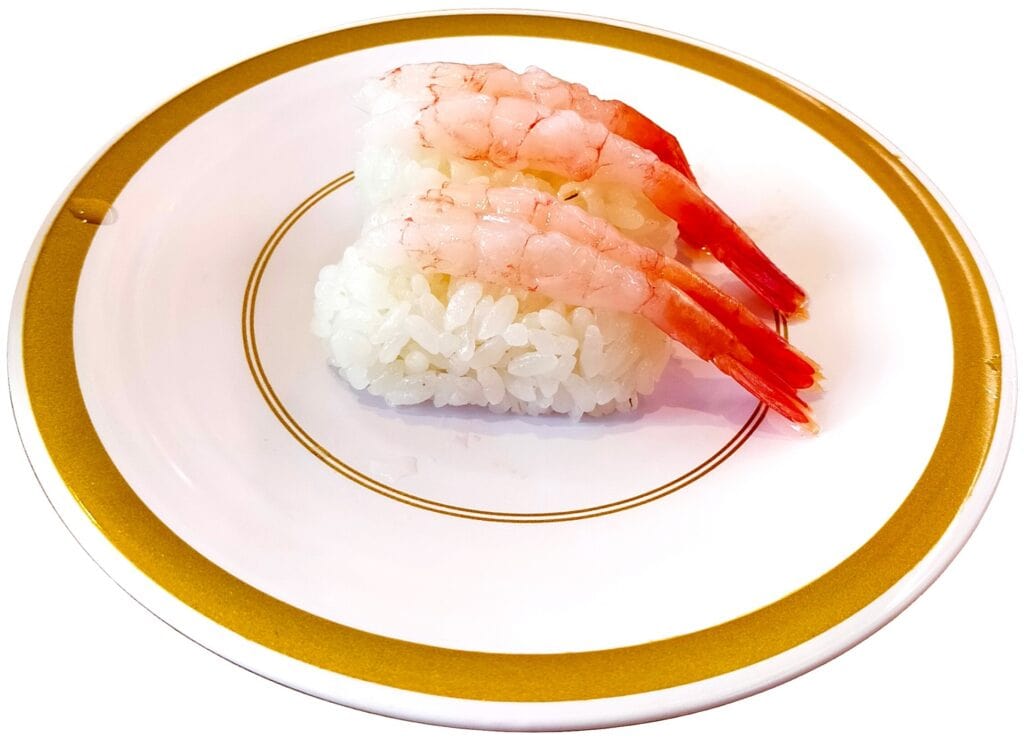
17.Sea Urchin (Uni) (1.8%) [tied]
Uni offers an intensely rich, creamy texture and distinctive ocean flavor that divides opinion but delights connoisseurs. Different varieties have different seasons—purple sea urchin peaks in summer, while northern sea urchin is best in spring through summer. Uni is rich in minerals, fiber, and vitamins A and E. It’s among the most premium sushi toppings, costing thousands of yen per piece at high-end restaurants. Even at conveyor belt sushi, it’s usually among the highest-priced items, with quality and origin significantly affecting price. Budget-conscious diners should check prices before ordering this luxury item.
Sea Urchin (Uni)
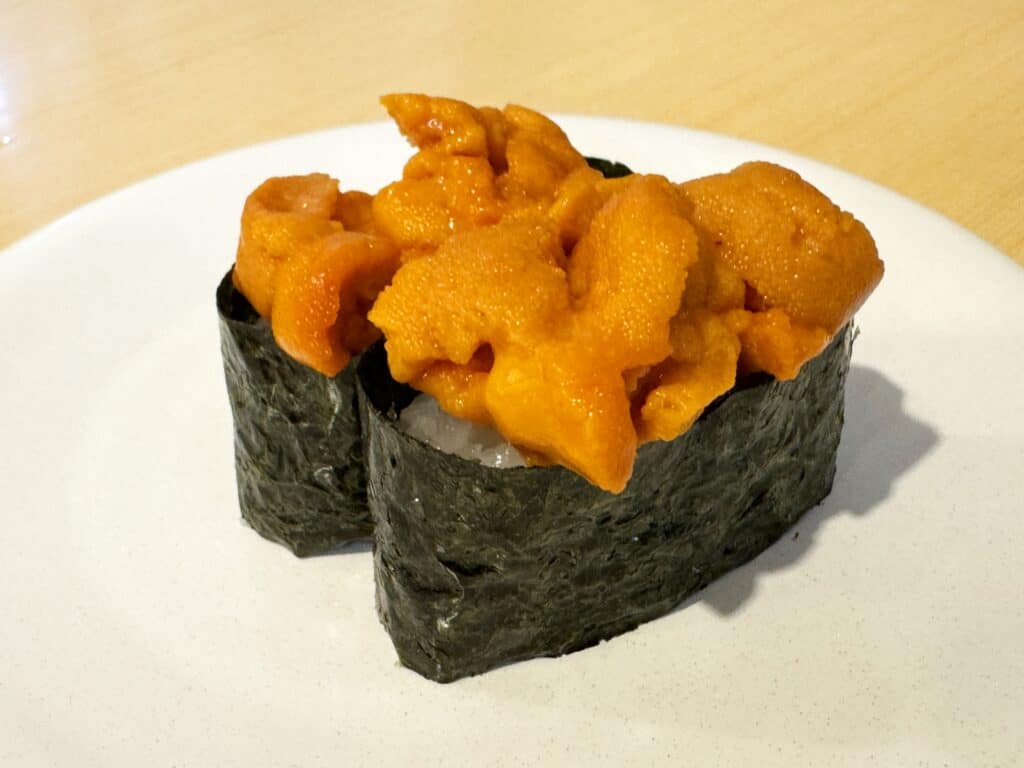
18.Whelk (Tsubugai) (1.6%)
Tsubugai offers a distinctive crunchy texture and flavor that intensifies as you chew. Especially prized in Hokkaido, it balances subtle sweetness with a hint of salinity. Its peak season is winter through spring. It’s low in fat but high in protein, with taurine, iron, and zinc. Whelk typically falls into the mid-range price category at kaiten-sushi restaurants.
Whelk (Tsubugai)

19. Horse Mackerel (Aji) (1.4%)
Aji offers a clean flavor with a perfect balance of light fattiness, particularly prized when extremely fresh. Its peak season is summer (June-August), when fat content and flavor are optimal. It’s rich in DHA, EPA, B vitamins, and vitamin D. Horse mackerel is typically offered at reasonable prices at conveyor belt restaurants.
Horse Mackerel (Aji)
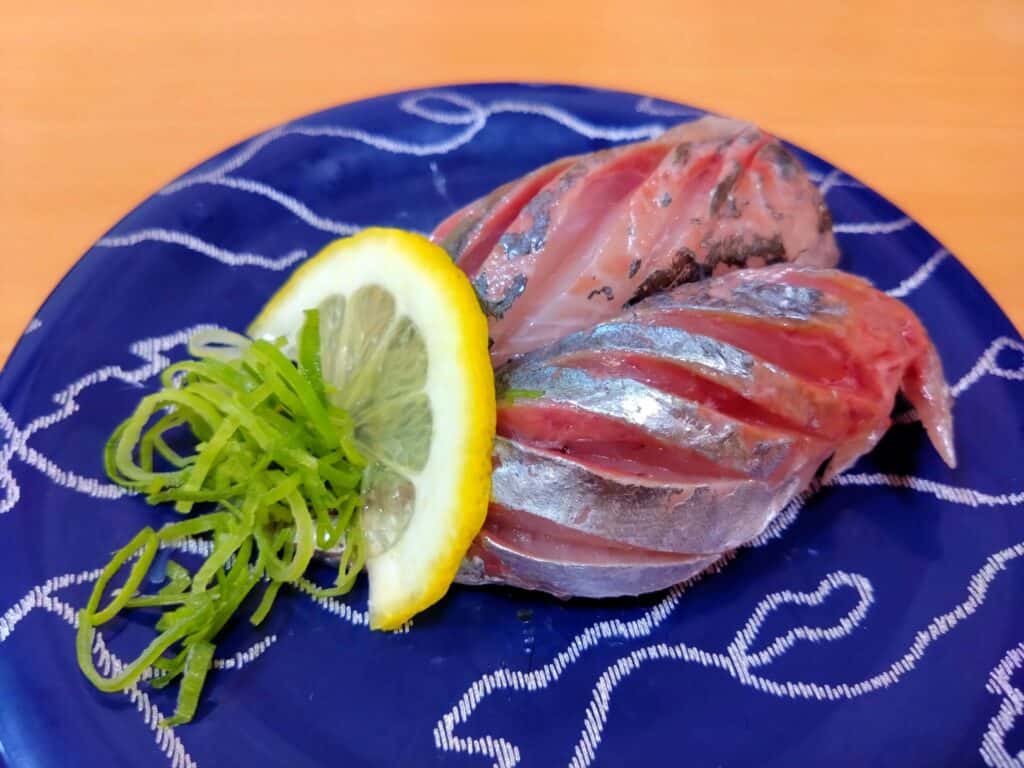
19. Vinegared Mackerel (Shime Saba) (1.4%) [tied]
Shime saba is mackerel cured in vinegar, creating a harmonious balance between the fish’s rich flavor and the vinegar’s refreshing acidity. This preparation technique reduces the distinctive oiliness of mackerel while preserving its umami. Mackerel peaks from autumn through winter, when its fat content is optimal. It’s exceptionally rich in omega-3 fatty acids (DHA and EPA), along with B vitamins and vitamin D. The vinegar curing improves preservation and makes it more approachable for those who find raw fish challenging. Vinegared mackerel is usually reasonably priced at kaiten-sushi restaurants.
Vinegared Mackerel (Shime Saba)
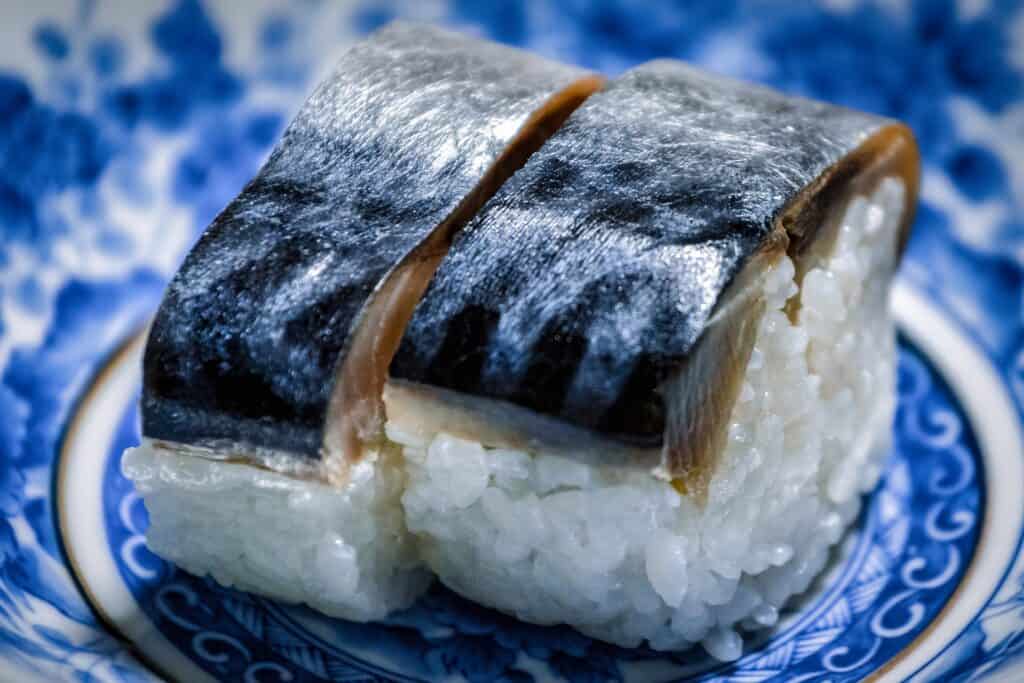
Popular Side Dishes at Kaiten-Sushi Restaurants
1. Special Steamed Egg Custard (Chawanmushi)
This silky savory custard features a delicate egg base infused with dashi broth, typically containing chicken, ginkgo nuts, mushrooms, and shrimp. A perfect complement to sushi, chawanmushi offers high-quality protein and various vitamins from its ingredients. Especially popular in colder months, this warming side dish showcases each restaurant’s special dashi recipe. Prices typically range from ¥100-300, making it an affordable luxury.
Special Steamed Egg Custard (Chawanmushi)
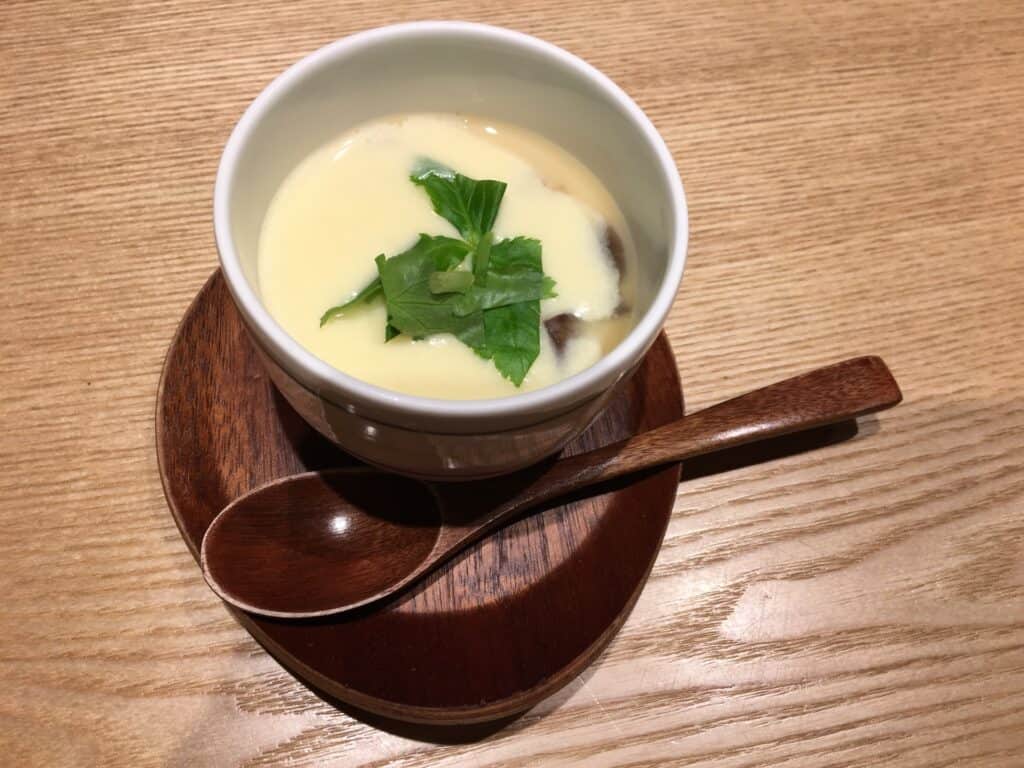
2. Seaweed Soup (Aosa Miso Shiru)
This soup featuring aosa seaweed delivers a refreshing ocean aroma. Rich in minerals, vitamins, calcium, and iron from the seaweed, it’s a nutritious palate cleanser between sushi courses. The light yet flavorful broth makes it a perfect accompaniment to fatty sushi toppings. Most kaiten-sushi chains offer this staple for around ¥100, making it one of the most affordable side dishes.
Seaweed Soup (Aosa Miso Shiru)
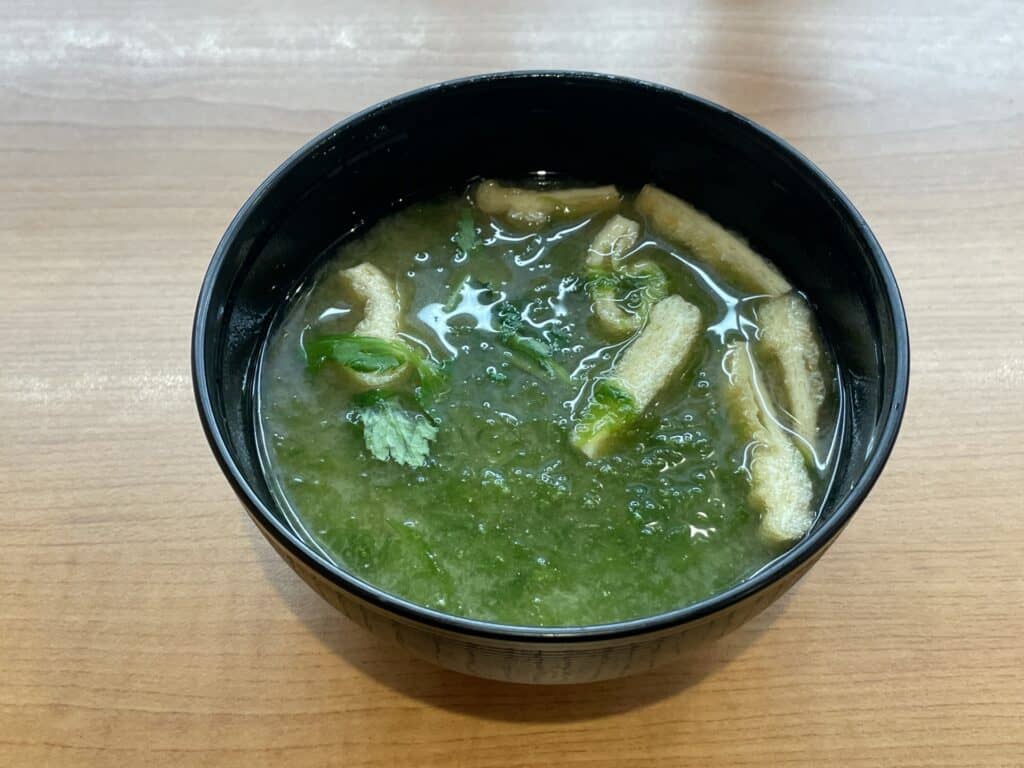
3. Fish Head Soup (Ara-jiru)
This luxurious soup is made from fish bones, heads, and other parts typically not used for sushi, extracting maximum flavor from the whole fish. Rich in collagen, calcium, and DHA, ara-jiru is both nutritious and sustainable. Each restaurant may use different fish varieties depending on the season, with their own special recipes for extracting the deepest flavor. Prices typically range from ¥150-300.
Fish Head Soup (Ara-jiru)

4. Clam Miso Soup (Asari Miso Shiru)
The natural sweetness of clams creates a deeply flavorful miso soup that complements sushi perfectly. Rich in taurine, which supports liver function, along with iron and vitamin B12, this soup is particularly delicious in spring when clams are in season. The briny flavor of clams pairs beautifully with the savory miso, creating a satisfying side dish. Prices typically range from ¥100-200.
Clam Miso Soup (Asari Miso Shiru)
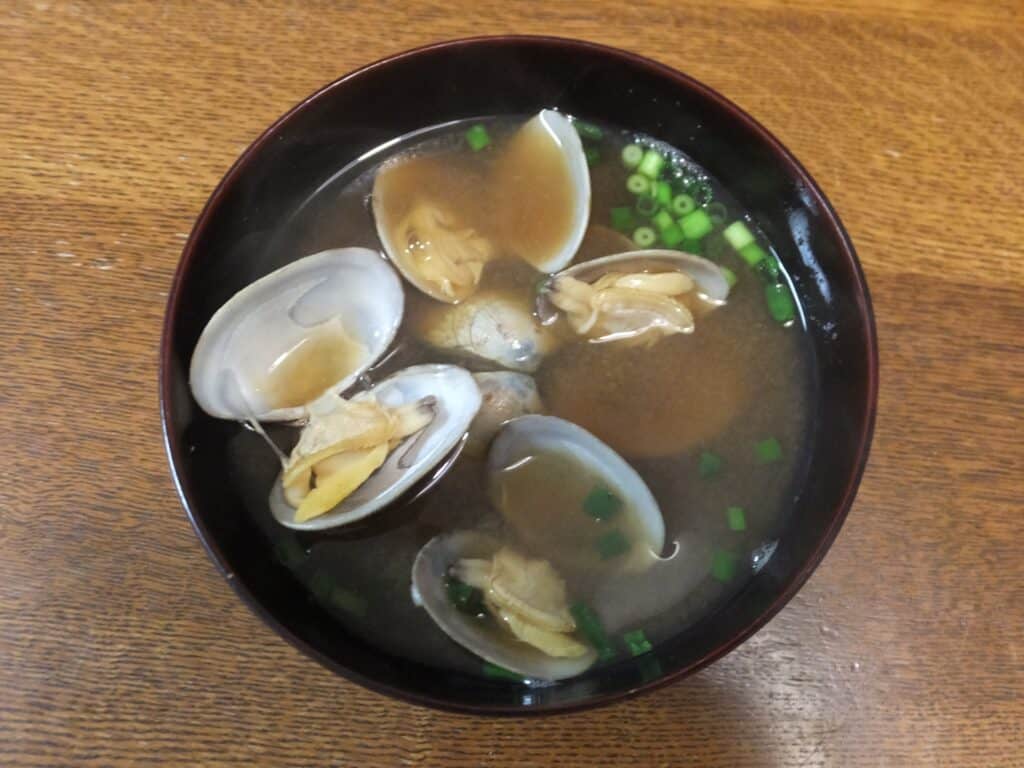
5. Kitsune Udon
This comforting noodle dish features chewy udon topped with sweet-savory fried tofu (aburaage). Popular with diners of all ages, it offers a substantial alternative when you need a break from sushi. The plant-based protein and fiber from the fried tofu help balance the meal. Priced at ¥300-500, this hearty option is especially popular with families.
Kitsune Udon
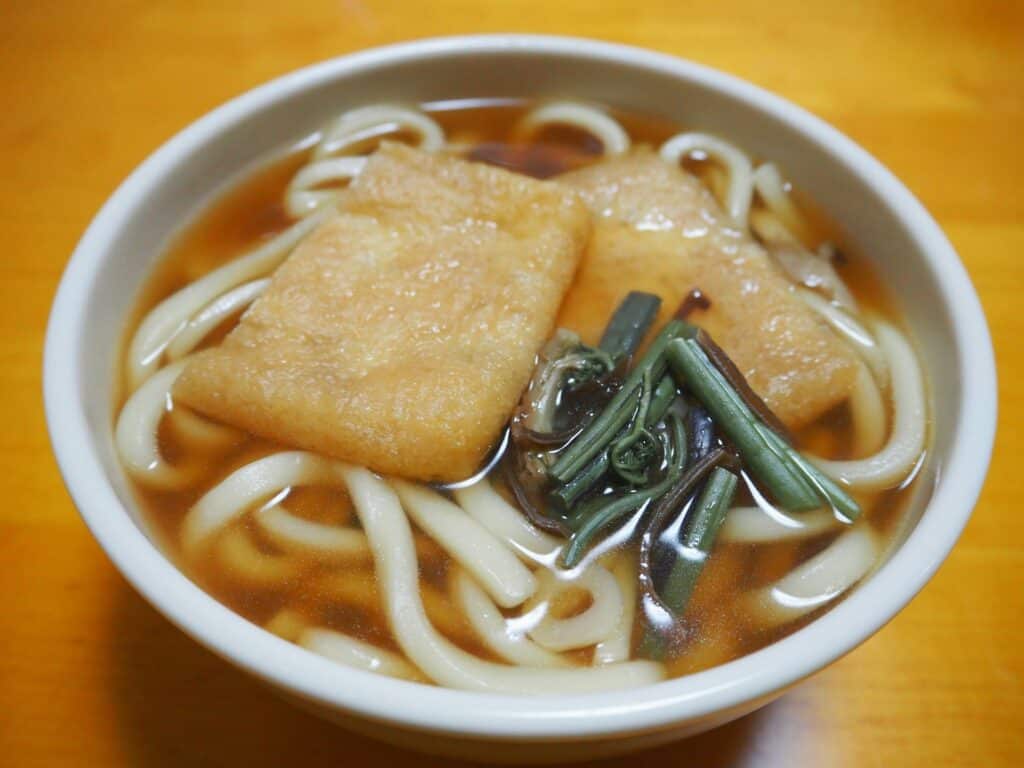
6.French Fries
This surprisingly popular side dish at Japanese kaiten-sushi reflects the family-friendly approach of these restaurants. The crispy texture offers a counterpoint to soft sushi, making it popular with children and international visitors. Some restaurants elevate their fries with special seasonings like truffle salt or shrimp salt. Containing vitamin C and potassium, these ¥200-300 side dishes are especially popular with family groups.
French Fries
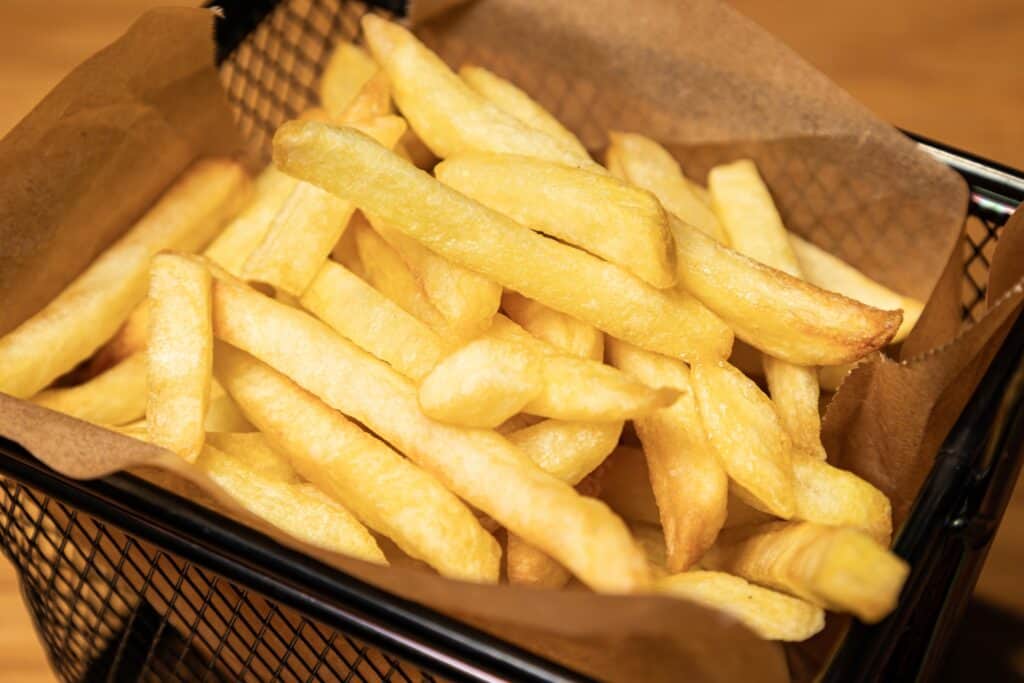
7. Ramen (Soy Sauce, Salt, or Sea Bream Broth)
For diners seeking more substantial fare alongside their sushi, many kaiten-sushi restaurants offer various ramen styles. It’s worth noting that kaiten-sushi ramen typically contains about half the amount of noodles compared to specialized ramen shops, making it a perfect side dish rather than a full meal. While standard flavors like soy sauce, salt, and miso are available, we recommend trying the seafood-based options like sea bream broth ramen, where kaiten-sushi restaurants can leverage their expertise with fresh fish. These seafood broths are where conveyor belt sushi chains truly shine in the ramen category, offering flavors that regular ramen shops can’t easily match. Nutritionally, these dishes provide carbohydrates from the noodles and minerals from the broth. Priced at ¥350-500, they’re more affordable than dedicated ramen shops while offering a unique seafood-forward experience.
Ramen (Sal & Sea Bream Broth)
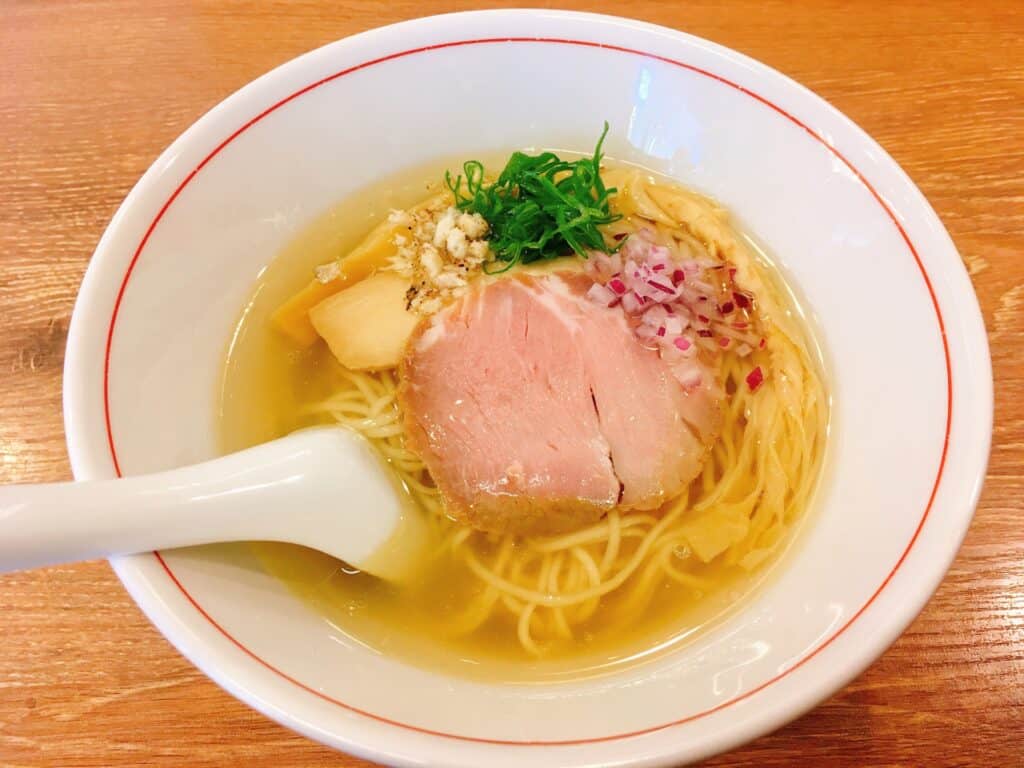
8.Tempura Udon
Crispy tempura (usually shrimp and vegetables) atop hot udon noodles creates a satisfying side dish, especially popular in winter. The combination offers balanced nutrition with carbohydrates from noodles and protein from tempura. The rich dashi broth ties everything together for a complete mini-meal. At ¥400-600, it’s among the pricier side options but offers substantial value.
Tempura Udon
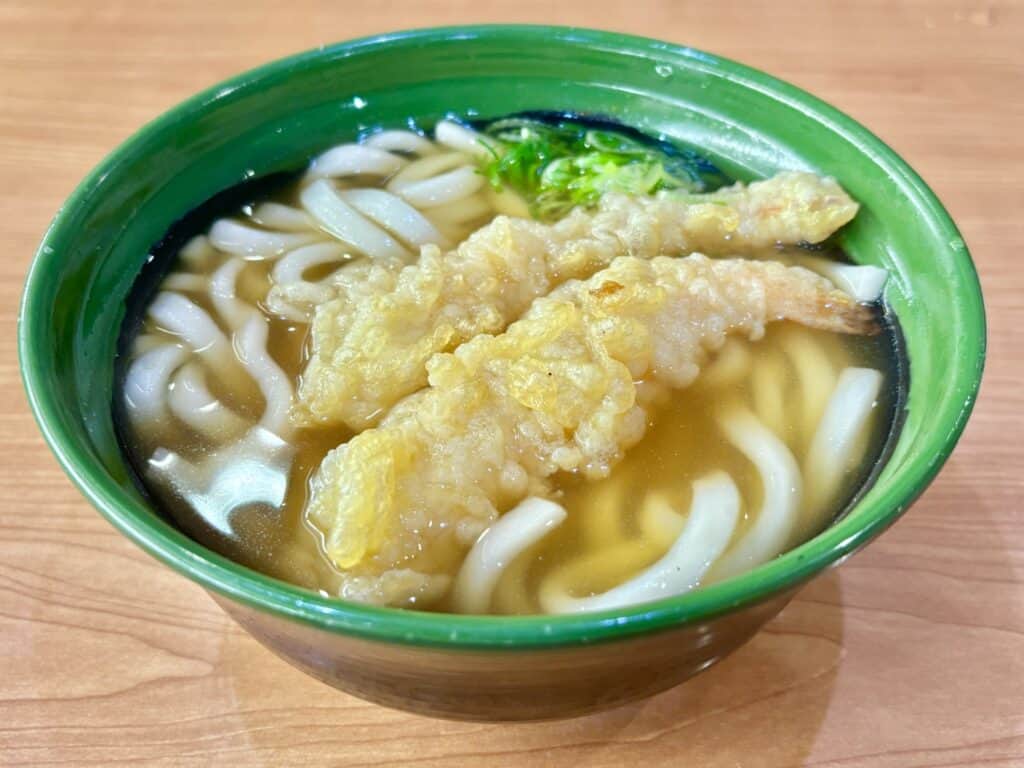
9. Fried Chicken
Freshly fried chicken pieces are especially popular with children and younger diners. Restaurants often offer various flavors from spicy to mild, with their own special marinades and coatings. Rich in protein and usually served in shareable portions, fried chicken is a popular order for families and groups. Prices typically range from ¥300-500.
Fried Chicken

10. Takoyaki
These ball-shaped snacks containing octopus pieces are a beloved Osaka specialty now found nationwide at kaiten-sushi chains. Crispy outside and tender inside, topped with savory sauce, bonito flakes, and mayonnaise, takoyaki offer a perfect between-sushi bite. The octopus contains taurine, which may help with fatigue recovery. Typically served in portions of 4-8 pieces for ¥300-500.
Takoyaki
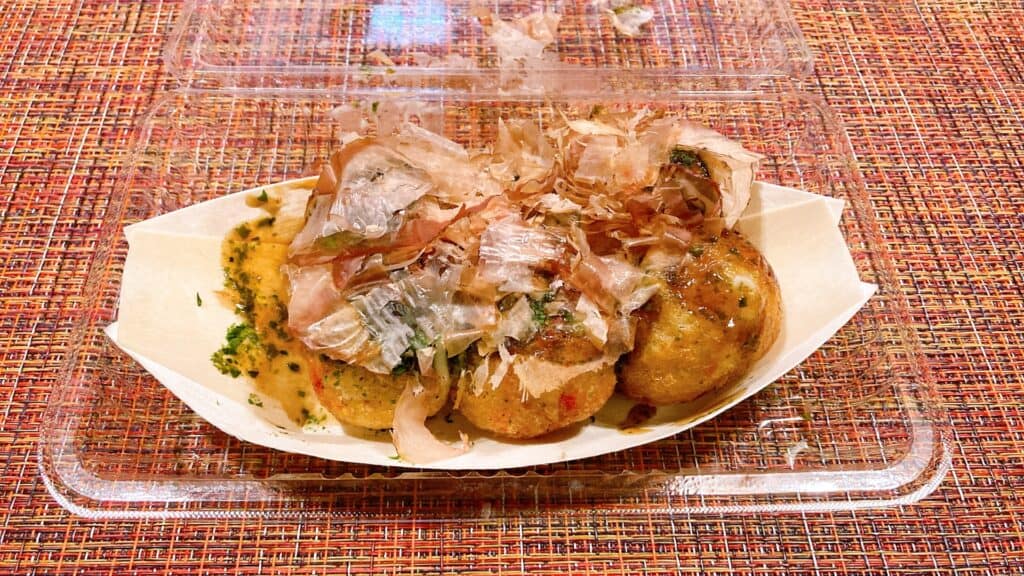
Popular Desserts at Kaiten-Sushi Restaurants
Each kaiten-sushi chain develops its own signature desserts and sweets, frantically diversifying their menus with various parfaits, ice creams, traditional Japanese sweets, and cakes. This intense competition for dessert innovation helps attract and retain customers, particularly women and families who might otherwise not choose sushi for their dining experience.
1. Parfaits
These visually stunning layered desserts are especially popular with female customers. Featuring seasonal fruits, various flavors like matcha or chocolate, and decorative elements, parfaits are designed to be both delicious and Instagram-worthy. They provide vitamins from fruits and calcium from ice cream. Though relatively expensive at ¥400-700, their elaborate presentation makes them a special treat worth sharing on social media.
Parfaits

2. Ice Cream
This simple yet satisfying dessert comes in various flavors from vanilla and matcha to seasonal specialties. Some kaiten-sushi chains offer premium branded ice creams or unique regional flavors. Rich in calcium and available in kid-friendly presentations, ice cream ranges from affordable standards at ¥100-300 to premium options around ¥500.
Ice Cream
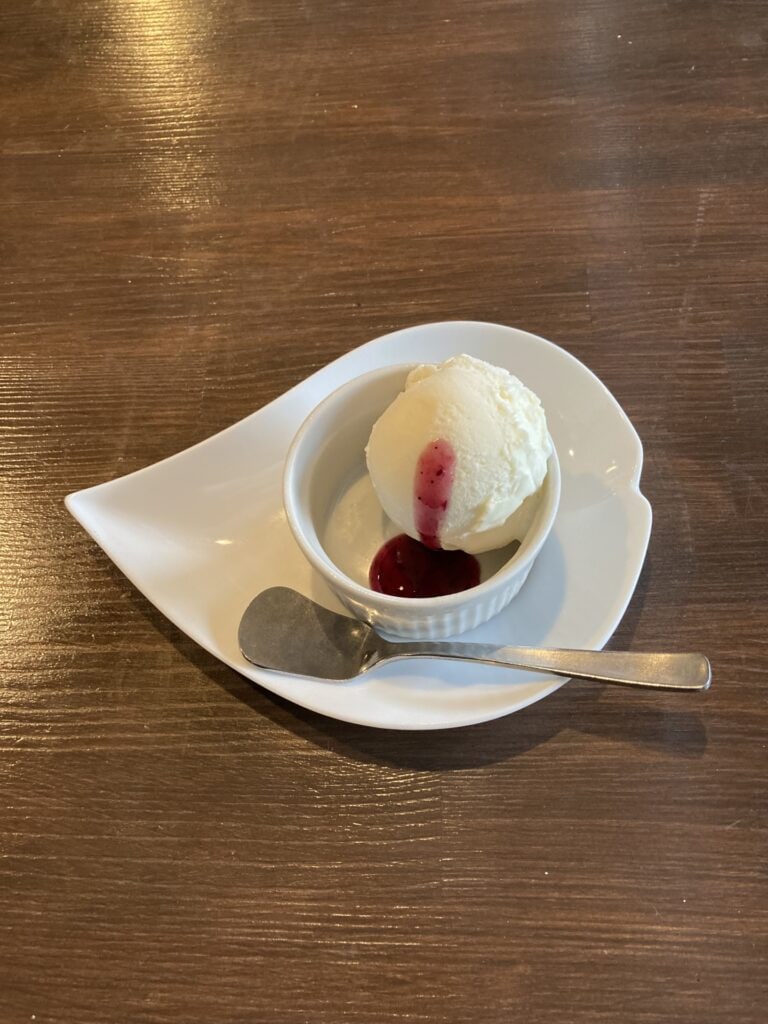
3.Candied Sweet Potatoes (Daigaku Imo)
These caramelized sweet potato pieces offer a perfect balance of natural sweetness and crispy caramel coating. Popular as a traditional Japanese dessert, daigaku imo contains fiber, beta-carotene, and potassium. Especially popular with health-conscious female customers, they’re available in both warm and cold versions depending on the season. Typically priced at ¥200-300.
Candied Sweet Potatoes (Daigaku Imo)
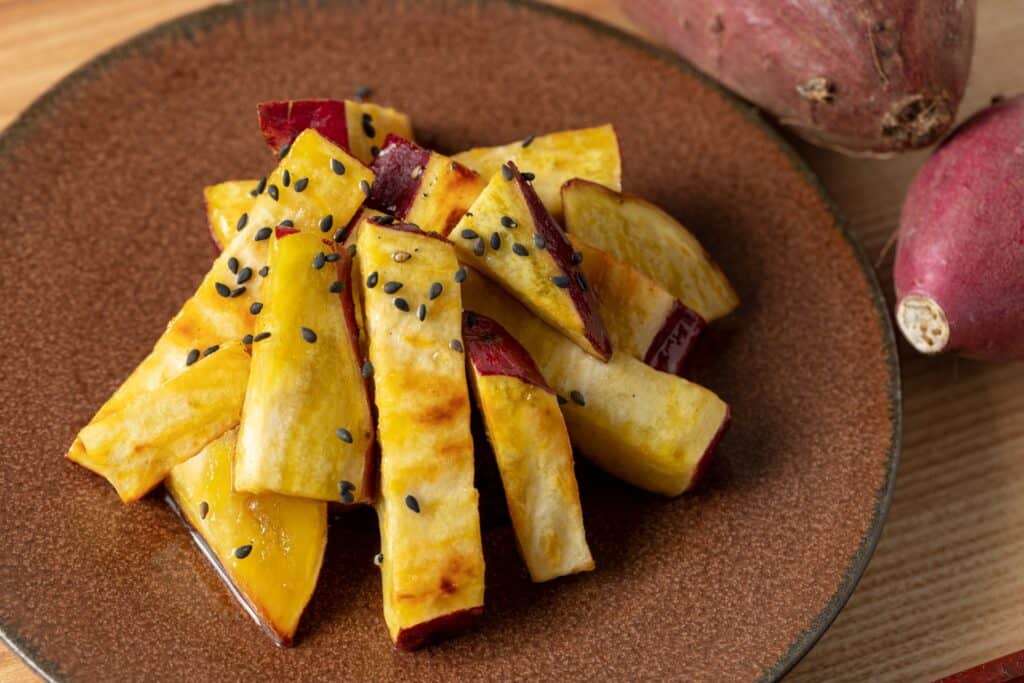
4. Cakes and Puddings
Rich cheesecakes, light mousses, and silky smooth puddings provide Western-style sweet options at many kaiten-sushi restaurants. Particularly popular with women and families with children, these desserts sometimes feature seasonal limited editions or collaborations with famous patisseries. Nutritionally, they offer calcium and protein, especially from cheese-based desserts and egg-rich puddings. Prices typically range from ¥300-500.
Cakes and Puddings
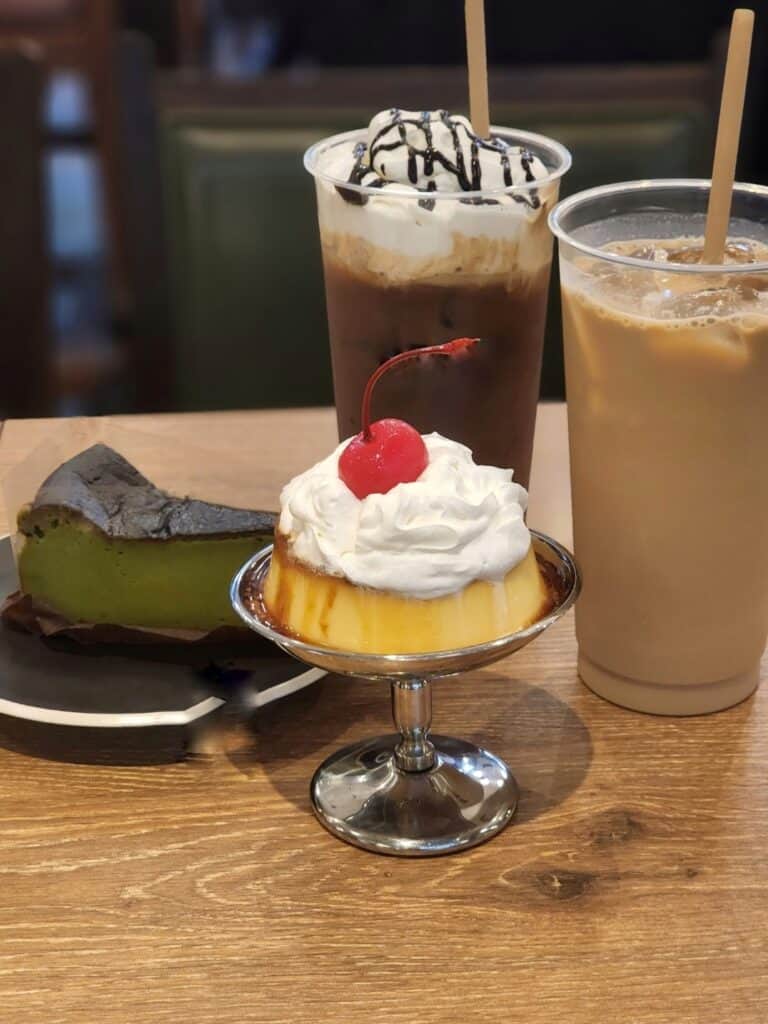
5.Traditional Japanese Sweets (Wagashi)
Anmitsu (agar jelly with sweet bean paste), shiratama dango (sweet rice dumplings), and warabi mochi (bracken starch jelly) offer elegant, less sweet finishes to a sushi meal. These traditional options pair naturally with Japanese cuisine and often feature seasonal variations like sakura mochi in spring. They typically contain fiber from bean paste and carbohydrates from rice flour. Priced from ¥200-400, wagashi offers an authentic end to the Japanese dining experience.
Traditional Japanese Sweets (Wagashi)
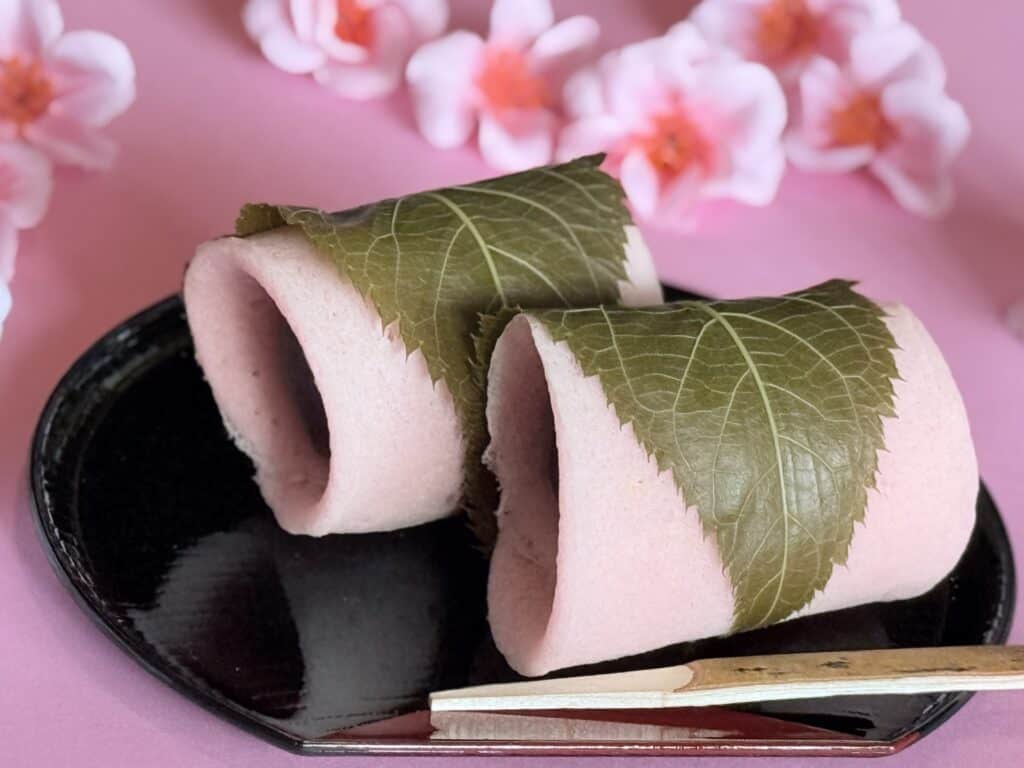
Conclusion
Kaiten-sushi restaurants cater to diverse customers by offering much more than just sushi. Their expansive menus of side dishes and desserts particularly target families and female customers who might not be drawn to traditional high-end sushi establishments. By combining sushi with familiar comfort foods, substantial sides, and eye-catching desserts, these restaurants create a complete dining experience accessible to everyone.
The side dishes complement sushi perfectly—from Japanese classics like chawanmushi to kid-friendly options like french fries. Desserts range from traditional Japanese sweets to Instagram-worthy parfaits, ensuring a satisfying finale to any meal. This diversity represents the unique appeal of kaiten-sushi that sets it apart from traditional sushi restaurants, making Japanese sushi culture accessible to visitors from around the world.
While high-end sushi restaurants focus on the purity of the sushi experience for their corporate clients, kaiten-sushi chains continuously innovate to attract a broader audience. This strategy has transformed conveyor belt sushi from a simple affordable sushi option into a comprehensive dining destination that appeals to Japanese families and foreign visitors alike.



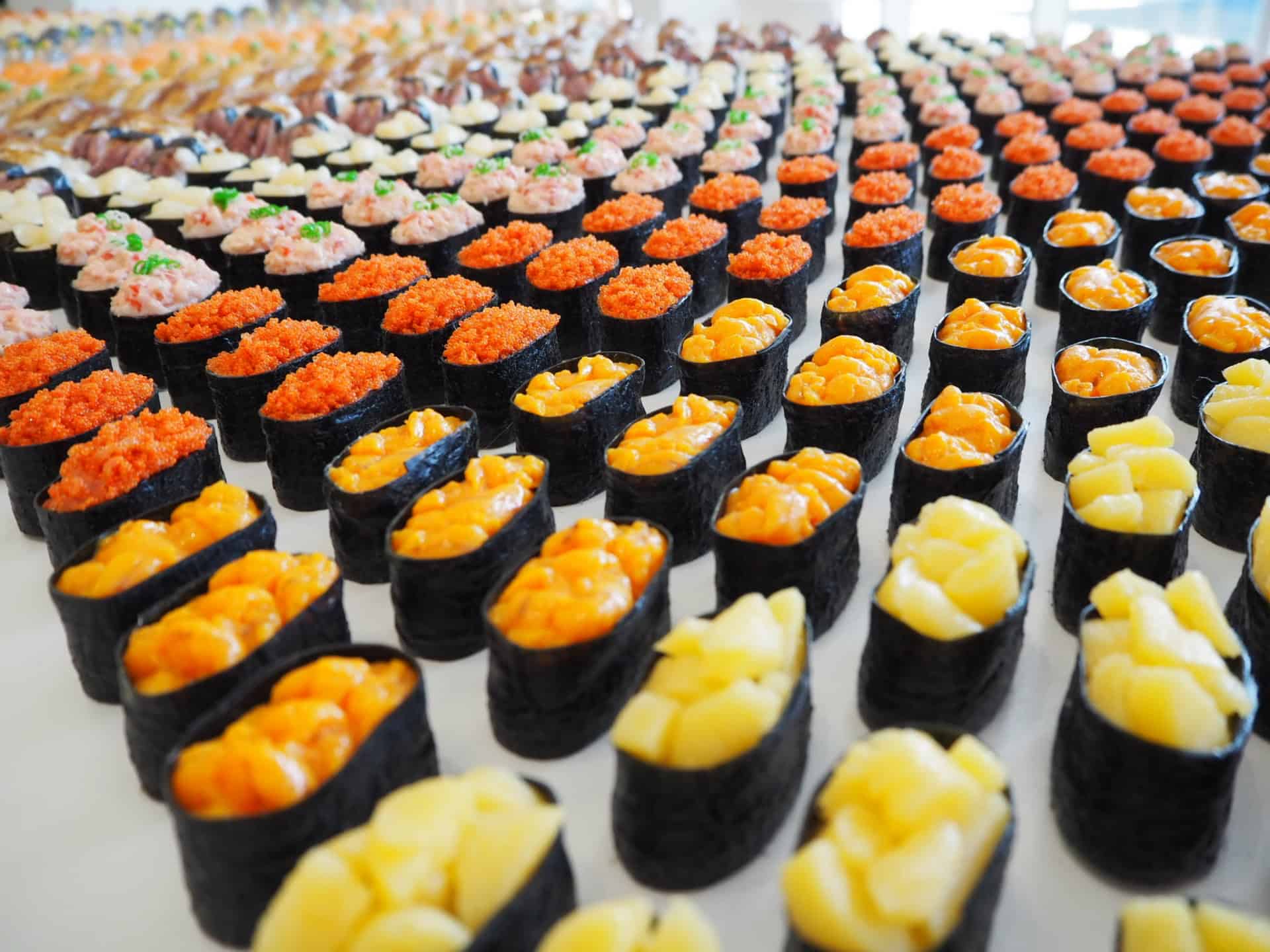

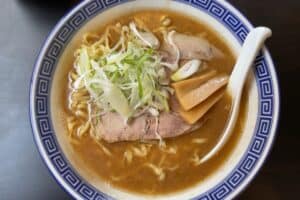
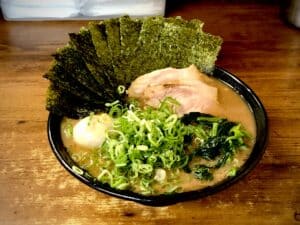
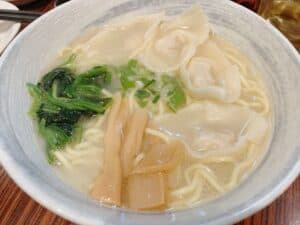

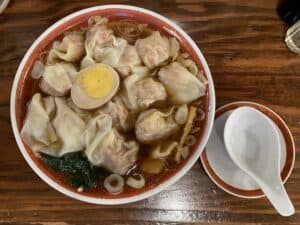

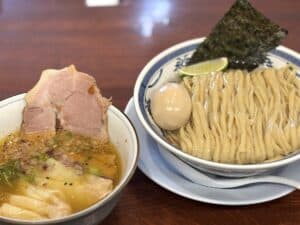
コメント
コメント一覧 (1件)
[…] Top 20 Popular Sushi Toppings at Kaiten-Sushi in Japan [With Side Dishes & Desserts Guide] Kaiten-sushi (conveyor belt sushi) restaurants have become an iconic part of Japanese food culture, […]